GETTING STARTED WITH SUPERCOMPUTING
Example #1: Missile Trajectory Simulation
1.0 Introduction
This example investigates a standard physics problem of missile trajectory, the typical
scenario of a projectile launched toward a target which is a known distance away. The problem
is to find which combinations of launch angle and corresponding velocity would be needed in
order for the projectile to land arbitrarily close to that target. However, instead of solving the
problem analytically [11], the following presentation uses a computational science approach.
2.0 Equations of the Model
As shown in figure 1, the height y of the projectile at time t is defined as:
y = vy * t - 0.5 * a * t2
where vy is the component of velocity in the vertical direction and a is the acceleration toward
earth by the force of gravity.
|

Figure 1: Basic Model Parameters
|
The horizontal distance x travelled during time t is defined by the simple equation:
x = vx * t
where vx is the component of velocity in the horizontal direction.
Given the initial velocity v and launch angle theta, the components of velocity can be
obtained using simple trigonometry:
vx = v * cos(theta)
vy = v * sin(theta)
3.0 Model Prototype
3.1 Creating the Initial Prototype
The first step in creating a computational model is to develop a simple prototype and then
validate it against known behavior. For this example, a possible first stage might be to display
a simple graphic showing the position of a projectile over time given an initial velocity and
launch angle. The number of points plotted on the screen depends upon the time step, or the
length of time between successive values of t. The following pseudocode describes the basic
algorithm.
Enter Values:
-
v (velocity),
theta (launch angle),
dist (target distance),
range (error margin or acceptable radius for "hit" )
Initialize Variables:
-
t=0 (time),
tstep = 0.1 (time step between calculations)
a=32 (Gravitational constant in ft per sec2)
Find velocity components:
-
vx=v*cos(theta)
vy=v*sin(theta)
Loop through all combinations:
- Repeat
-
t = t + tstep (Increment time step)
y = vy * t - 0.5 * a * t * t (Calculate height)
x = vx * t (Calculate horizontal distance )
plot(x,y) (Plot position of projectile )
Until y <= 0 (Until missile has hit the ground)
Test for accuracy:
-
If Abs(x-dist) < range
-
then result = Hit
else result = Miss
|

Figure 2: Trajectories at 60 Degree Angle
140 ft/sec and 150 ft/sec
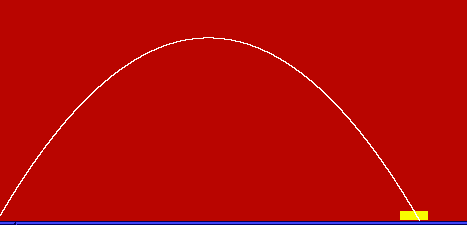
Projectile Hits the Target at 150 ft/sec at an angle of 60 degrees
|
Figure 2 shows the plot of a projectile shot at two different velocities but at the same
angle of 60 degrees. The distance to the target for the simulation is 600 feet, the error margin
was 20 feet, and the time step was 0.2 seconds. Notice that a projectile fired at 150 ft/sec would
hit the target whereas an attempt at 140 ft/sec would fall short of the mark.
3.2 Validation of the Prototype
Validation of a computer simulation model is one of the most important steps of any
investigation. No matter how intricate a model might be, if that model does not adequately
define the situation, there is no sense in drawing any conclusions from the simulation. In all
computer models, there are certain simplifying assumptions that must be made since it is not
possible to accurately simulate every single detail. Therefore, it is important that these
simplifications do not interfere with the integrity of the model.
In this example, one possible behavior to validate is that the flight path of the projectile
follows an expected parabolic curve. This can be done graphically. Another detail to establish
is an appropriate time step between consecutive values of t in order to have predictable results
when the projectile finally hits the ground. The time step could be made extremely small to
increase accuracy, but that would make the execution time of the simulation much greater.
Supercomputers are able to calculate at very rapid speeds, but there is no sense in wasting
computer cycles unnecessarily.
To be sure that the model works correctly, it should be tested with several combinations
of parameters where the behavior can be carefully analyzed and compared with known results.
Good values to check are examples from mid-range as well as the extremes. Deviations from
known behavior must be studied carefully and any problems corrected if the results are to be
meaningful.
4.0 Expanding to a Supercomputer Application
Modern supercomputers are able to compute at hundreds of millions to even billions of
calculations per second. Yet, unless algorithms are designed properly, much of that potential will
never be accessed. The key to unleashing the computational power of most supercomputers is
to find a way to do many similar calculations in parallel. Some supercomputers use a technique
called vectorization which handles arithmetic with large arrays using a method similar to an
assembly line. In other supercomputers, the same primary calculation is done by many separate
processors simultaneously, but with different initial values.
The basic prototype simulation runs easily on a microcomputer and certainly does not
require a supercomputer. However, to make this a supercomputer application, the problem can
be expanded to compare a full an entire range of velocities between 0 and 1000 feet per second
with all possible launch angles between 0 and 90 degrees. That is a lot of calculations, but a
supercomputer should be able do much of the work in parallel in order to produce results more
rapidly. The desired outcome showing a complete picture of acceptable combinations is very
computationally intensive, but just right for a supercomputer.
5.0 Displaying Results
To analyze the results, it would be possible to print a list of ordered pairs that are
solutions, but a better approach might be to select a visualization technique using graphics. The
method chosen for this example uses each pixel position on the screen to represent a different
combination of distance and launch angle. Horizontal pixel coordinates stand for different
velocities and vertical coordinates represent variations in launch angle. There are many
combinations to try, and thus, very many simulations to run. In standard VGA graphics, there
are 640 pixels horizontally by 480 pixels vertically, or 307,200 combinations. A supercomputer
may be able to do many of these calculations simultaneously, although a standard PC would have
to try each combination separately.
For each of the defined positions, the prototype model described earlier must go through
its full simulation and then decide whether the combination of parameters produced a hit or miss.
The screen position is then colored differently depending upon the result: a darker shade for a
hit, or two alternating lighter shades for a miss.
The graphic image in figure 3 shows the results for the expanded model. The horizontal
axis represents velocity, the vertical axis represents launch angle, and the solution set is clearly
visible by the dark curved line. However, the simulation took several hours to complete on a PC
running Turbo Pascal, and any enhancements would make execution time even longer.
Therefore, it is a perfect candidate for a supercomputer application.

Figure 3: Computational Science Solution
Angle vs. Velocity
An interesting byproduct of the graphics visualization process in this example is the
unusual pattern in the background. The design happens because the simulation plotted alternating
colors for various distances which missed the target. The pattern is a function of not only how
often the color changes (every foot versus every ten feet), but also the value used for the time
step in the simulation.
6.0 Comparison to the Analytical Solution
There is also a purely mathematical solution to this investigation which is not too difficult
to derive. Using the basic equations of the model combined with the fact that when the projectile
strikes the target, the vertical height is zero yet the horizontal length equals the distance from
source to target, it is possible to solve a system of equations which can be resolved into one form
defining velocity in terms of launch angle, given various constants for target distance and
gravitation. That relationship produces a graph that shows the same solution set described by
the computational approach. It is defined by the following equation:
v = SQRT(( a * dist)/(2 * SIN(theta) * COS(theta)))
So why use a computational model when mathematical solution is obviously more exact?
For one reason, if there is desire to expand the model to include other factors such as wind
resistance, spins, bounces, and interference with various obstacles, then an analytical approach
becomes increasingly more difficult. However, modifications to the computational model are
comparatively easy since only additions to the basic simulation need to be defined.
There are times when the computational model may be the only alternative. In fact, some
situations which seem relatively simple cannot be solved analytically at all. During the first
SuperQuest contest, former student Eric Scheirer developed a new technique [20] to analyze one
such unsolvable problem, the classic "three body problem". The difficulty in finding an
analytical solution for three planets having mutual gravitational attraction is related to their
interdependencies of that gravitational pull. Using a supercomputer simulation and a graphics
display technique similar to the trajectory model, Eric was able to gain a partial understanding
of the dynamics of that system.
Computational models are not fool proof either, for there are often difficulties with chaotic
behavior and sensitivity to initial conditions. However, a carefully designed computational
approach can often provide some insight into many "unsolvable" problems in mathematics and
science.
7.0 Understanding the Trajectory Model
There are several things that the missile trajectory investigation can show. The
visualization technique not only defines acceptable values for velocity and launch angle by means
of a graph, but also shows that for a broad range of angles on either side of 45 degrees, the
velocity required for a hit is not nearly as sensitive as it is at the extremes. When the angle
approaches either zero degrees or 90 degrees, a slight change in angle requires a significant
change in velocity in order to make a hit. This relationship, although intuitively obvious, is very
clearly shown by the compu
ter graphics.
Computational science models can provide alternative methods for investigating problems
of all kinds. With the aid of graphics visualization, scientists can often gain additional insight
into many research investigations. Sometimes an unrelated aspect of the display, such as the
patterned background in the trajectory example, might be the inspiration for yet another project.
8.0 Extensions to the Basic Model
After students are introduced to the simple trajectory model, they
are expected to make the model more complex by adding obstacles
that could interfere with the path of the projectile. Students could
add walls, objects that had gravitational fields, or any creative
physics principle they wished.
Below is an example project by student
Tom Dixon demonstrating the
effects of a gravitational attractor deflecting the path of
a projectile.
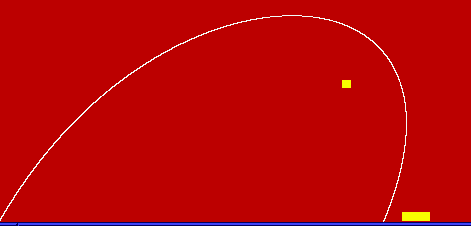
Projectile Deflected by a Gravitational Attractor
|
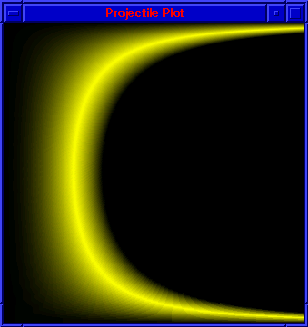
Normal Plot of Solution Set
|
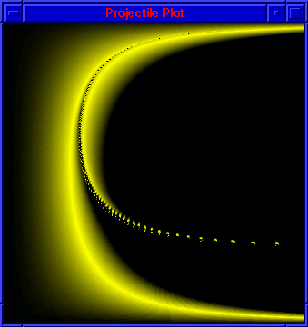
Effects of Gravitational Attractor
|
The following is an example by student David Rosenthal that shows the
effect of a repelling influence.
The white region indicates the combinations that
were closest to the target, with the color gradations showing
relative distances from the target. Notice the deforming
of the solution set due to a gravitation-like influence that
repulsed the object rather than attracting it.
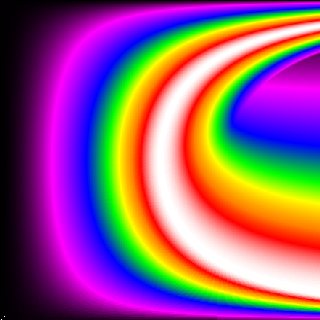
Normal Simulation
|
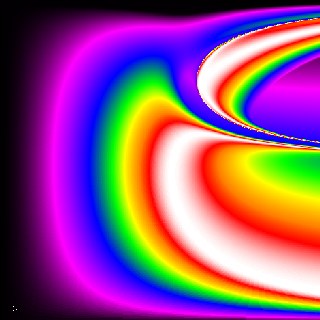
Repelling Influence
|









